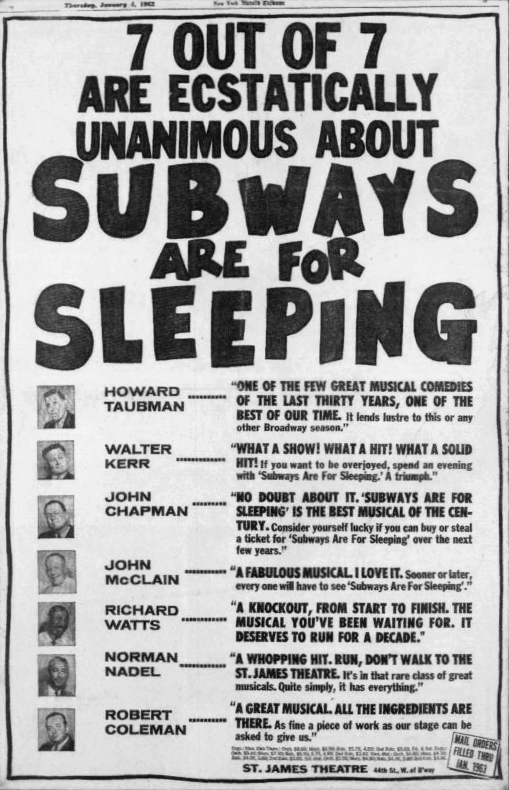
It was January of 1962. The Broadway production of Subways are for Sleeping at the St. James Theatre was getting weak reviews. Ticket revenues were low, and in need of some magic.
Producer David Merrick had a trick up his sleeve that he had been saving for several years. He spent some time making some interesting arrangements, and then prepared the following advertisement for every major New York newspaper.
It included the names of the most prominent theatre critics of the time, followed by over-the-top enthusiastic reviews:

“7 out of 7 are ecstatically unanimous about Subways are for Sleeping.”
Howard Taubman: “One of the few great musical comedies of the last thirty years, one of the best of our time. It lends lustre to this or any other Broadway season.”
Walter Kerr: “What a show! What a hit! What a solid hit! If you want to be overjoyed, spend an evening with ‘Subways are for Sleeping.’ A triumph.”
John Chapman “No doubt about it. ‘Subways are for Sleeping’ is the best musical of the century. Consider yourself lucky if you can buy or steal a ticket for ‘Subways are for Sleeping’ over the next few years.”
John McClain: “A fabulous musical. I love it. Sooner or later, everyone will have to see ‘Subways are for Sleeping’.”
Richard Watts: “A knockout, from start to finish. The musical you’ve been waiting for. It deserves to run for a decade.”
Norman Nadel: “A whopping hit. Run, don’t walk to the St. James Theatre. It’s in that rare class of great musicals. Quite simply, it has everything.”
Robert Coleman: “A great musical All the ingredients are there. As fine a piece of work as our stage can be asked to give us.”
Merrick’s ingenious trick: He rounded up seven men who were not reviewers of theatre, but happened to have the exact same names as the ideal set of critics to be quoted.
He treated them all to a free showing of the production with other perks, and coaxed the published quotes out of each. Nowhere in the ad does it say that these individuals are affiliated with any newspaper or have any other credentials. It is, in fact, a completely truthful piece of information, though a deliberately misleading one.
Merrick might have used this trick earlier in his career, but he had been unable to find anyone with the same name as Brooks Atkinson. Atikinson retired in 1961, opening the way for Merrick’s inventiveness.
Only the Herald-Tribune ran the ad. One of the other papers examined the photographs, and realized that the pictured individuals were not, in fact, the reviewers being implied by the piece. The word spread among the rest of the papers that had not yet gone to press.
That one newspaper, however, provided much-needed publicity for the show. It went on for over 200 more performances, and even earned a Tony Award: Best Featured Actress in a Musical, for Phyllis Newman.


![By ABC Television (eBay front back) [Public domain], via Wikimedia Commons](https://broadwayiq.com/wp-content/uploads/2015/01/Phyllis_Newman_1966-150x150.jpg)